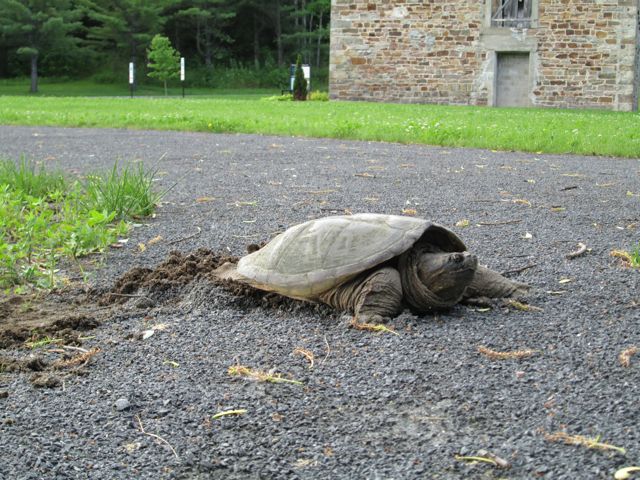Peru parks offer a new attraction
This past Sunday two snapping turtles could be seen burying their eggs – one near the entrance to the Fellowship Center and the other in Little Ausable Park. This morning this mommy was trying her luck in Heyworth/Mason Park. Here are a few snapping turtle facts.
From NYSDEC’s webpage about snapping turtles:
- The snapping turtle is a very aggressive predator and one of the largest turtles in North America.
- It often buries itself in the mud with only its nostrils and eyes showing, waiting for unsuspecting prey. These turtles will snap at anything they find threatening. Their snap is so powerful that it can easily shear fingers – so stay a safe distance away! Snapping turtles live 30-40 years on average. The snapping turtle is New York’s official state reptile.
And from The Waterman and Hill-Traveller’s Companion, a Natural Events Almanac out of Illinois:
- Female snapping turtles have the ability (as do most turtles) to plan their pregnancies. Sperm cells from the male survive in the female’s reproductive tract for up to three years in a specialized duct so that when food is plentiful and life is good she can fertilize any eggs she happens to be carrying. When the eggs ripen (usually in mid June in our area) she develops a wanderlust and leaves the water (one of the few times these turtles willingly leave the water) to search for a suitable location to lay her eggs.
- Snapping Turtles will sometimes lay their eggs considerable distances from the water – up to a quarter mile away has been recorded. Once the site is chosen she digs a bottle-shaped hole with her hind feet as deep as she can reach – which can be up to eight inches. She then lays from ten to thirty ping pong ball sized eggs and covers them with the previously excavated soil grading it smooth with her lower shell and tail. Depending on the temperature, rainfall and moisture content of the nest the eggs the eggs hatch in from 55 to125 days after laying. In northern climes some nests overwinter with hatching occurring in the spring of the following year. Around here most nests have hatched by the end of September.
Read more on their website: http://www.naturealmanac.com/archive/snappers/snappers.html
Posted: June 3rd, 2013 under Education News, Environmental News, General News, Peru/Regional History, Things to do in & near Peru, Town Board News.

